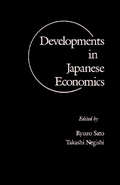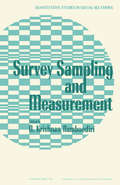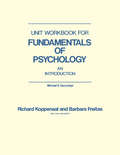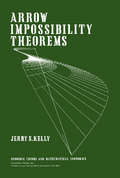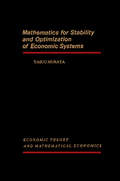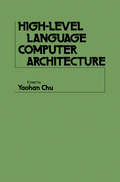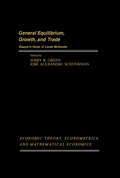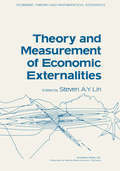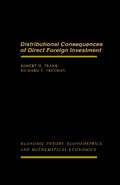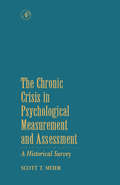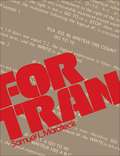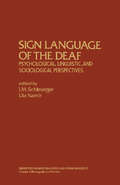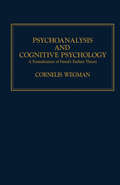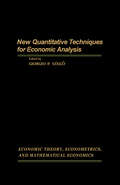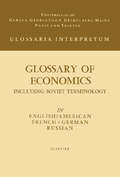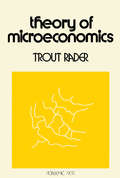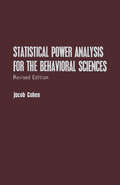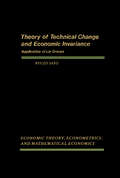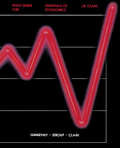- Table View
- List View
Developments in Japanese Economics
by Ryuzo Sato Takashi NegishiDevelopments in Japanese Economics provides information pertinent to the fundamental aspects of the developments in Japanese economics. This book presents the process innovative aspect of Japanese science and technology.Organized into three parts encompassing 12 chapters, this book begins with an overview of the heterogeneous capital goods model that is stable even with an infinitely short forecast. This text then emphasizes that the changes in capital accumulation are relevant for economic growth and decline. Other chapters consider the examples of how Japanese economists apply theory to empirical endeavors. This book discusses as well the durable capital stock of the Japanese manufacturing industries. The final chapter attempts to investigate the validity of the theory of self-dual demand functions, which can be integrated into consumer's utility function, by using both Japanese and U.S. data.This book is a valuable resource for economists, sociologists, political scientists, financial historians, statisticians, and research workers.
Advanced Lectures in Quantitative Economics
by Frederick Van Der PloegAdvanced Lectures in Quantitative Economics summarizes some of the efforts of a second-phase program for first-rate candidates with a Master's degree in economics who wish to continue with a doctoral degree in quantitative economics.This book is organized into three main topics—macroeconomics, microeconomics, and econometrics. This text specifically discusses the Neo-Keynesian macroeconomics in an open economy, international coordination of monetary policies under alternative exchange-rate regimes, and prospects for global trade imbalances. The post-war developments in labor economics, introduction to overlapping generation models, and measurement of expectations and direct tests of the REH are also elaborated. This monograph likewise covers the dynamic econometric modeling of decisions under uncertainty and fundamental bordered matrix of linear estimation.This publication is a good reference for students and specialists interested in quantitative economics.
Survey Sampling and Measurement
by N. Krishnan NamboodiriSurvey Sampling and Measurement contains the invited papers presented at the Second Symposium on Survey Sampling held at Chapel Hill in April 1977. The volume is divided into seven parts. Part I makes a plea towards improving the quality of sample surveys via the creation of a computerized system of information on error estimates associated with the design and execution of surveys. It also suggests a realistic agenda for future work in survey sampling practice and theory. Part II contains papers dealing with specific methodological problems. Part III examines selected problems of analysis of survey data. The papers in Part IV deal with nonresponse, undercoverage, and related problems. Part V focuses on time series analysis. Part VI discusses applications of sample survey data and methods. Part VII addresses the gap between current survey practices and recent theoretical developments. It is hoped that this volume will be of interest to survey statisticians as well as to survey data users. If it stimulates thoughtful and courageous attack on some of the unresolved problems in survey sampling, its mission will have been amply fulfilled
Unit Workbook for Fundamentals of Psychology: An Introduction
by Michael S. Gazzaniga Richard Koppenaal Barbara FreitasUnit Workbook for Fundamentals of Psychology
Arrow Impossibility Theorems
by Jerry S. KellyArrow Impossibility Theorems is a 10-chapter text that describes existing impossibility theorems. This book explores a number of formalizations of ethical constraints of the theorems.After an introduction to the framework and notation for Arrow impossibility theorems, this book goes on discussing some concepts and an apparatus of relations among those concepts which are important for the theorems. Other chapters present some impossibility results that serve to point out serious difficulties in some plausible escape routes from the theorems of earlier chapters. The final chapter describes important areas of research that have arisen in the collective choice field in the transition away from studying the conditions of Arrow's theorem alone to the totality of all impossibility theorems.This book is intended primarily for economists.
Mathematics for Stability and Optimization of Economic Systems
by Yasuo MurataEconomic Theory and Mathematical Economics: Mathematics for Stability and Optimization of Economic Systems provides information pertinent to the stability aspects and optimization methods relevant to various economic systems. This book presents relevant mathematical theorems sufficient to develop important economic systems, including Leontief input–output systems, Keynesian dynamic models, the Ramsey optimal accumulation systems, and von Neumann expanding economic systems.Organized into two parts encompassing nine chapters, this book begins with an overview of useful theorems on matrices, eigenvalue problems, and matrices with dominant diagonals and P-matrices. This text then explores the linear transformations on vector spaces. Other chapters consider the Hawkins–Simon theorem concerning non-negative linear systems. This book discusses as well the dual linear relations and optimization methods applicable to inequality economic systems. The final chapter deals with powerful optimal control method for dynamical systems.This book is a valuable resource for mathematicians, economists, research workers, and graduate students.
High-Level Language Computer Architecture
by Yaohan ChuHigh-Level Language Computer Architecture offers a tutorial on high-level language computer architecture, including von Neumann architecture and syntax-oriented architecture as well as direct and indirect execution architecture. Design concepts of Japanese-language data processing systems are discussed, along with the architecture of stack machines and the SYMBOL computer system. The conceptual design of a direct high-level language processor is also described.Comprised of seven chapters, this book first presents a classification of high-level language computer architecture according to the proximity of the machine language and the programming language. This classification gives four types: von Neumann architecture, syntax-oriented architecture, indirect execution architecture, and direct execution architecture. In order to illustrate the possible evolution of computer architecture, design concepts of Japanese-language data processing systems are chosen as an example. Subsequent chapters focus on the syntax-oriented architecture; the historical SYMBOL computer system which makes use of an indirect execution architecture; and design concepts of direct-execution architecture for the ALGOL 60 language. The final chapter describes the architecture for the processor for an APL subset.This monograph will be of interest to specialists in electronics and computer science.
General Equilibrium, Growth, and Trade: Essays in Honor of Lionel McKenzie
by Jerry R. Green Josè Alexandre ScheinkmanGeneral Equilibrium, Growth, and Trade: Essays in Honor of Lionel McKenzie provides information pertinent to the three main areas of Professor McKenzie's scientific research, namely, international trade, economic growth, and general equilibrium theory. This book highlights the main aspects of McKenzie's work.Organized into three parts encompassing 21 chapters, this book begins with an overview of the regularizing effects of aggregation over nonregular microrelations. This text then examines the theory of a multiperiod monopolist incurring nonseparable labor adjustment costs, which is developed when investment is irreversible. Other chapters consider the behavior of a price-maker in a competitive market as a preliminary step to a more complete analysis of pure competition. This book discusses as well the effects of uncertainty on optimal decisions, which constitutes an increasingly essential area of economic research. The final chapter deals with the general equilibrium macroeconomic model.This book is a valuable resource for economists and economic theorists.
Theory and Measurement of Economic Externalities
by Steven A. Y. LinTheory and Measurement of Economic Externalities provides information on some analytical and empirical developments in the field of externalities. This book presents the function of turning out producer's goods in the form of better knowledge, analytical formulation, and approaches for application to current problems.Organized into five parts encompassing 12 chapters, this book begins with an overview of the notion of externalities in connection with analyses of economic welfare. This text then discusses the relationship between publicness and external diseconomies when either consumption or production or decision sets are nonconvex due to a high degree of externalities. Other chapters consider disproving the pessimistic conclusions concerning tax–subsidy schemes. This book discusses as well the solutions for the allocation of resources in an economy with public goods and interdependent preferences. The final chapter deals with a general framework for estimating externality production functions.This book is a valuable resource for economists.
Fundamentals of Psychology: An Introduction
by Michael S. GazzanigaFundamentals of Psychology: An Introduction focuses on issues that cut through the artificial boundaries commonly held in the study of behavior. The book reviews the nature of the organism in terms of basic neurology, including the neurological organization of the central nervous system and the general features of brain development. The author also examines the normal course of development of the visual systems. He discusses fixed patterns of behavior and the developmental processes that include emotional behavior, self-control, language use, perceptual, and cognitive development. The author then explains the use of statistical concept in psychological research, as well as the psychological methods of inquiry that involves variable manipulation and observation of effects. The author also discusses learning and motivation theory including the theories of Pavlov, Skinner, and Premack. He discusses the organism as an information processor using short- and long-term memory, and the mind as having physical aspects such as brain codes and a brain structure known as the corpus callosum. This book is helpful for psychiatrists, psychologists, behavioral scientists, students and professors in psychology.
Distributional Consequences of Direct Foreign Investment
by Robert H. Frank Richard T. FreemanDistributional Consequences of Direct Foreign Investment examines the net effect of direct foreign investment (DFI) on both U.S. employment demand in the short run and on the level and distribution of domestic income in the long run. Topics covered range from measurement of home-foreign substitution to the employment impact of DFI and the long-run distributional consequences of overseas investment. Short-run labor market adjustments to unemployment resulting from overseas production transfers are also discussed. Comprised of nine chapters, this volume begins with a survey of existing studies of the DFI phenomenon that critically evaluates the question of what firms would or could have done in the absence of a DFI alternative. The reader is then introduced to an alternative framework within which to estimate the degree of substitutability of home for foreign production. This framework consists of a microeconomic model of the multinational firm as it operates under two alternative policy regimes, one of which places no restrictions on the firm's activities and the second denies it the option of establishing a foreign production subsidiary. Input-output techniques, together with information on substitutability, are used to obtain estimates of the net employment impact of DFI. A probabilistic model of an industry labor market is also presented. In addition, the book analyzes the effect of technology transfer through licensing on the size and composition of domestic income.This monograph will be useful to practitioners who employ econometrics and mathematical economics.
The Chronic Crisis in Psychological Measurement and Assessment: A Historical Survey
by Scott T. MeierThe Chronic Crisis in Psychological Measurement and Assessment: A Historical Survey provides a historical survey of relevant concepts in psychological measurement and assessment. It does not delve into intimate details and complexities, but traces measurement and assessment controversies over time and across psychological domains. The main goal has been to approach the problems of measurement and assessment from the perspective of psychological theory. The book begins with an overview, a broad picture of how psychological measurement and assessment have evolved. Separate chapters present descriptions and interpretations of measurement issues that have been important over the lifespan of psychological science. Traditional approaches along with newer concepts and procedures are are discussed, along with an attempt to integrate the major themes that emerge from the historical survey with the ultimate purpose of reviewing and proposing new directions. This book is offered as a complement to existing texts in psychological measurement and assessment.
Quantitative Economics and Development: Essays in Memory of Ta-Chung Liu
by L. R. Klein M. Nerlove S. C. TsiangEconomic Theory, Econometrics, and Mathematical Economics: Quantitative Economics and Development: Essays in Memory of Ta-Chung Liu focuses on the advancements in the methodologies and processes in the field of quantitative economics.The selection first offers information on society, politics, and economic development, global stability of stochastic economic processes, and the design of mechanisms for the efficient allocation of public goods. Discussions focus on the design of individually incentive compatible mechanisms in an abstract setting, design problem under coalition formation, stability results for the economic models, invariant measures for diffusions, and disjoint principal-components method. The text then takes a look at critical observations on the labor theory of value and Sraffa's Standard Commodity and a generalization of Hotelling's solution.The manuscript examines an exploratory policy-oriented econometric model of a metropolitan area and the effect of simple specification error on the coefficients of "unaffected" variables, including distinctive features of the model and individual sectoral models. Temporal aggregation and econometric models; uniqueness of the representation of commodity-augmenting technical change; and technological change and growth performance in Taiwan agriculture are also discussed.The selection is a valuable source of data for economists and readers interested in quantitative economics.
FORTRAN
by Samuel L. MarateckFORTRAN is written for students who have no prior knowledge of computers or programming. The book aims to teach students how to program using the FORTRAN language.The publication first elaborates on an introduction to computers and programming, introduction to FORTRAN, and calculations and the READ statement. Discussions focus on flow charts, rounding numbers, strings, executing the program, the WRITE and FORMAT statements, performing an addition, input and output devices, and algorithms. The text then takes a look at functions and the IF statement and the DO Loop, the IF-THEN-ELSE and the WHILE loop, including applications of the DO loop, the LOGICAL declaration statement, library functions, other applications of the IF statement, and writing REAL constants in exponential form. The manuscript ponders on subscripted variables, the DATA statement, and the implied DO loop, doubly subscripted variables and matrix multiplication, input/output, and functions, subprograms, and subroutines. Topics include statement functions, subprograms calling other subprograms, reading using X format, control characters, reading using F format, INTEGER subscripted variables, and matrix multiplication. The publication is a dependable source of data for computer programmers and students interested in the FORTRAN language.
Sign Language of the Deaf: Psychological, Linguistic, and Sociological Perspectives
by I. M. Schlesinger Lila NamirSign Language of the Deaf: Psychological, Linguistic, and Sociological Perspectives provides information pertinent to the psychological, educational, social, and linguistic aspects of sign language. This book presents the development in the study of sign language.Organized into four parts encompassing 10 chapters, this book begins with an overview of the fascinating account of sign language acquisition by small children. This text then explores the grammar of sign language and discusses the linguistic status of natural and contrived sign languages. Other chapters consider the many peculiarities of the lexicon and grammar of sign language, and its differences in such respects from oral language. This book discusses as well sign language from the angle of psycholinguistics. The final chapter deals with the educational implications of the use of sign language.This book is a valuable resource for linguists and psycholinguists. Readers who are interested in sign language will also find this book useful.
Psychoanalysis and Cognitive Psychology: A Formalization of Freud's Earliest Theory
by Cornelis WegmanPsychoanalysis and Cognitive Psychology: A Formalization of Freud's Earliest Theory is an attempt to translate psychoanalytic theory into a computer model—a model psychoanalysts will accept as accurately mirroring Freud's theory, while at the same time satisfying the demands made upon any formal model within contemporary psychology. Given the vast extent and the continued development of psychoanalytic theory, the present study focuses on Freud's earliest theory. In a sense, this limitation is a natural one. Anyone really wishing to come to grips with psychoanalytic theory will listen to Freud's advice and follow the path he himself took. In his earliest theory, the theory of abreaction, Freud lays the foundation for all of his later work. Here, for the first time, we encounter concepts—psychical conflict, repression, unconscious ideas, the principle of constancy—which have proved decisive for the development of psychoanalytic theory. Moreover, this was the period during which Freud himself was obsessed by the idea of representing his theory in a single, coherent model, much as in natural science. The present monograph may be regarded as a belated effort to realize the ideal that Freud had in mind in his Project for a Scientific Psychology: a psychology in which psychical processes are represented in such a manner that they become ""perspicuous and free from contradiction"".
Evaluating the Quality of Learning: The SOLO Taxonomy (Structure of the Observed Learning Outcome)
by John B. Biggs Kevin F. CollisEducational Psychology Series: Evaluating the Quality of Learning: The SOLO Taxonomy (Structure of the Observed Learning Outcome) focuses on the approaches, methodologies, and techniques employed in the valuation of the quality of learning.The publication first offers information on the quality and quantity of learning and origin and description of the Structure of the Observed Learning Outcome (SOLO) taxonomy. Discussions focus on general intellectual development and the growth of quality; some assumptions and applications of stage theory; from developmental stage to levels of learning quality; and general intellectual development and the growth of quality. The text then examines the teaching of history, elementary mathematics, English, and geography. Topics include interpreting a map and drawing conclusions, explaining a natural phenomenon, appreciation of poetry, implications for the teaching of history, English, and mathematics, numbers and operations, and general application of SOLO to history. The manuscript takes a look at modern languages, place of the taxonomy in instructional design, and some methodological considerations. Concerns include alternative formats for obtaining SOLO responses, instructional processes, curriculum analysis, remediation, and teacher intentions. The publication is a vital source of data for educators interested in the SOLO taxonomy.
New Quantitative Techniques for Economic Analysis
by Giorgio P. SzegöEconomic Theory, Econometrics, and Mathematical Economics: New Quantitative Techniques for Economic Analysis provides a critical appraisal of the results, the limits, and the developments of well-established quantitative techniques. This book presents a detailed analysis of the quantitative techniques for economic analysis.Organized into four parts encompassing 16 chapters, this book begins with an overview of the general questions concerning models and model making. This text then provides the main results and various interesting economic applications of some quantitative techniques that have not been widely used in the economic field. Other chapters consider the principle of optimality in dynamic programing wherein the infinite sequence of consumption-saving decisions can be reduced to one decision. This book discusses as well the methods for online control and management of large-scale systems. The final chapter deals with special problems.This book is a valuable resource for economists, social scientists, epistemologists, economic historians, and research workers.
A Laboratory Introduction to Psychology
by James Allison John W. Ost William B. VanceA Laboratory Introduction to Psychology was written to acquaint the student with the concepts and methods of laboratory science as they apply to psychology. It is assumed that the laboratory course will follow or accompany a comprehensive course in introductory psychology which emphasizes scientific topics. The experiments have been related to journal articles and to sections of several popular textbooks so that students and instructors will have ready access to introductory material. This manual is limited to standard topics of experimental psychology, but includes some experiments that are relatively new. The topics discussed are grouped into in three main categories: Animal Behavior, Sensory Processes, and Human Behavior. Within each of these sections, the experiments are somewhat connected in shorter series. The Animal Behavior studies include one series consisting of conditioning, extinction, discrimination, and secondary reinforcement, and a second series on schedules of reinforcement and motivation. The experiments on Sensory Processes include some threshold measurements, and also a series of studies on perceived magnitude, adaptation level, and illusions. The experiments on Human Behavior include a series on learning and transfer, on short-term memory, and on two-person interactions.
Glossary of Economics: Including Soviet Terminology
by M. Clifford VaughanGlossary of Economics: Including Soviet Terminology focuses on semantic development in the field of economics. The book first offers information on the abbreviations used in economics and language indicators. These include the abbreviations for colloquial, feminine, masculine, neuter, plural, and indicators of the French and German languages.The manuscript then provides a basic table of economic terms in English with their French and Russian counterparts and an alphabetical tabulation of French and German economic terms. The text also elaborates on a Russian alphabetical and numerical index. A Russian to English tabulation of economic terminologies is also provided.The publication is a fine reference for economists and readers interested in the semantic development in economics.
Digital Computer Design: Logic, Circuitry, and Synthesis
by Edward L. BraunDigital Computer Design: Logic, Circuitry, and Synthesis focuses on the logical structure, electronic realization, and application of digital information processors.The manuscript first offers information on numerical symbols, fundamentals of computing aids, quantization, representation of numbers in an electronic digital computer, and computer applications. The text then ponders on the nature of automatic computation and Boolean algebra. Discussions focus on the advantages of a Boolean algebraic description of a digital computer; clock pulse generators and timing circuits; sequential switching networks; elements of information processing systems and types of digital computers; and automatic sequencing methods.The book elaborates on circuit descriptions of switching and storage elements and large capacity storage systems. Topics include static magnetic storage, dynamic delay line storage, cathode-ray storage, vacuum tube systems of circuit logic, and magnetic core systems of circuit logic. The publication also examines the system design of GP computers, digital differential analyzer, and the detection and correction of errors.The text is a valuable source of data for mathematicians and engineers interested in digital computer design.
Theory of Microeconomics
by Trout RaderTheory of Microeconomics provides information pertinent to the fundamental aspects of microeconomics. This book covers a variety of topics, including economic theory, resource allocation, production transformations, producer efficiency, utility functions, consumer efficiency, and trade efficiency.Organized into four parts encompassing 11 chapters, this book begins with an overview of the definition of economics and provides several views of the significance of theory in economics. This text then examines the role of mathematics in economic theory and discusses the mathematical background for the theory of production. Other chapters consider the formal structure of economics, which is elaborated and compared with the theory of resource allocations and with classical mechanics. This book discusses as well the properties of production, the neoclassical model of production, and the problem of producer efficiency. The final chapter deals with capital goods and financial assets.This book is a valuable resource for professional economists and graduate students in economics.
Statistical Power Analysis for the Behavioral Sciences
by Jacob CohenStatistical Power Analysis for the Behavioral Sciences, Revised Edition emphasizes the importance of statistical power analysis. This edition discusses the concepts and types of power analysis, t test for means, significance of a product moment rs, and differences between correlation coefficients. The test that a proportion is .50 and sign test, differences between proportions, and chi-square tests for goodness of fit and contingency tables are also elaborated. This text likewise covers the F tests of variance proportions in multiple regression/correlation analysis and computational procedures. This publication is intended for behavioral and biosocial scientists who use statistical inference, but also serves as a supplementary textbook for intermediate level courses in applied statistics in behavioral/biosocial science.
Theory of Technical Change and Economic Invariance: Application of Lie Groups
by Ryuzo SatoTheory of Technical Change and Economic Invariance: Application of Lie Groups presents the economic invariance problems observable behavior under general transformations such as taste change or technical change. This book covers a variety of topics in economic theory, ranging from the analysis of production functions to the general recoverability problem of optimal dynamic behavior.Organized into nine chapters, this book begins with an overview of the theory of observable behavior by analyzing the invariant relationships among economic variables. This text then examines the Lie group theory which provides one of the most efficient methods of studying invariance properties. Other chapters consider the analysis of exogenous technical change, a process partly due to dynamic market forces of supply and demand. This book discusses as well the topics closely related to parametric changes under Lie groups and related transformations. The final chapter deals with mathematical foundations of the theory of observable market behavior.This book is a valuable resource for economists.
Study Guide for Essentials of Economics
by J. R. ClarkStudy Guide for Essentials of Economics is a valuable support tool for the student using Essentials of Economics. It provides several important features that contribute to a good course which cannot be included in the standard textbook, and if used correctly it will improve understanding of, and ability to apply, economic principles to everyday decision-making.The book contains self-test questions, problems and projects, and perspectives in economics. Topics covered in the text include economic approaches, tools of the economist, supply, demand, and the market process, and money and the banking system. An answer key is provided at the end of the book.This text is intended for students of economics.
